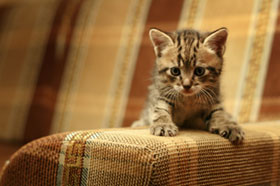Don’t Believe It! Exposing 10 Common Myths about Cats
 A lot of ancient "wisdom" about felines isn't so wise after all.
A lot of ancient "wisdom" about felines isn't so wise after all. Some of it is just plain silly – and some is downright dangerous.
Sources: Shine from Yahoo.com, June 22, 2010
Dr. Becker's Comments:
"The following are ten urban legends about our kitty companions that deserve debunking:
Myth: Cats always land on their feet.
Fact: Cats don't have collarbones, their backbones are very flexible, and they are extremely graceful animals. This may have led to the old wives tale that they always land on their feet. However, the way your kitty is constructed is no guarantee he won't be harmed in a fall.
Myth: You should give your cat cow's milk.
Fact: Adults of any species typically have trouble digesting the milk of another species – and that includes cats. Like humans, many cats are also lactose intolerant, and cow's milk offers no nutritional value to your kitty.
Myth: All cats hate water.
Fact: Many cats are intensely curious about the wet stuff and love moving water – a sink faucet, a water fountain for drinking, a running shower, even a flushing toilet.
Myth: Dry cat food (kibble) is best for cats because it helps clean their teeth.
Fact: Crunchy food isn't any better at brushing and flossing your kitty's teeth than it is yours. From a nutritional standpoint, dry food is the worst thing you can feed your cat – it is devoid of both the healthful, unadulterated protein and moisture cats need in order to stay healthy.
Myth: Cats that live indoors don't get sick or need to see the veterinarian regularly.
Fact: While it's true indoor living is much safer and healthier for domesticated kitties, they still need regular wellness visits to a holistic or integrative veterinarian. And no matter where your cat spends her time, if she's not eating a species-appropriate, nutritionally balanced diet, she's at risk for poor health. An annual physical examination and blood work to detect early organ dysfunction is priceless, in terms of being a proactive pet owner.
Myth: If you have a cat at home with an infant, the cat will be attracted to the scent of milk and can suck the air from the baby's mouth, suffocating it.
Fact: There is absolutely no evidence cats are attracted to an infant's breath, nor has there ever been a case where a cat has suffocated an infant in this manner. If you find your cat snoozing with your baby, it's because kitties like to snuggle up against warm bodies, especially in quiet, darkened rooms – which nurseries often are. Sometimes fat cats are bigger than tiny infants, hence the recommendation to keep the cat out of the nursery.
Myth: Declawing is just a permanent nail trim.
Fact: Declawing is the surgical amputation of the first joint of each of a cat's toes, and is increasingly viewed as inhumane and a form of mutilation.
Myth: Cats thrive on a vegetarian diet.
Fact: Cats are obligate carnivores, designed by nature to require animal protein. In fact, human-grade, unprocessed protein and moisture (water) should make up the bulk of your kitty's diet. Regardless of your own feelings about eating meat, please don't compromise your cat's health by feeding him a vegan or vegetarian diet.
Myth: Cats are cold and aloof. If you want a loving, loyal pet, get a dog.
Fact: Many cats are very loving. Cats are not dogs, so other than having four legs, a tail and fur like their canine counterparts, they are very different animals and comparisons don't make much sense. Dogs are by nature pack animals, while kitties are more independent. But cats that enjoy the same status in the family as dogs are often just as loving, attentive and present as their canine buddies.
Myth: Cats have nine lives.
Fact: Utter nonsense! Cats are smart, so it may appear they are "luckier" than dogs.
Myth: All calico cats are female
Fact: I grew up with a calico, and I actually thought this one was true – until I did a little research and discovered I was wrong. It actually has to do with a genetic anomaly. Female cats carry two X chromosomes, while males carry an XY pair. For a cat to be calico, it needs the XX set, which means – most of the time – they’re female. But sometimes a genetic mutation can add extra Y – and an XXY set means a male cat. These rarities are called Klinefelter cats, and they are usually sterile."
______________________Today:
We were supposed to be taking today off to catch up on things.
But when I went outside, Ray was trying to install another new keyed lock on his patio door, that I had just bought. It just wasn't fitting. He is still having lock trouble with the new patio door of the guest house that we installed back in June. So Ray and I went to Lowes in the next town to see what they thought about it. We took the new lock, and the one off the old door with us. We have tried about 6 locks so far. We came back with no more information that when we left. When I got home, I finally contacted the manufacturer of the door, and they are supposed to be sending a new lock.
That just about killed my time off today.
















No comments:
Post a Comment